
Postage Stamps of the United States - 1926
Politics
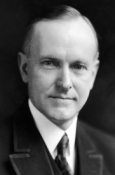
President
Calvin Coolidge
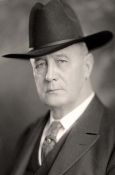
Postmaster General
Harry S. New
Music
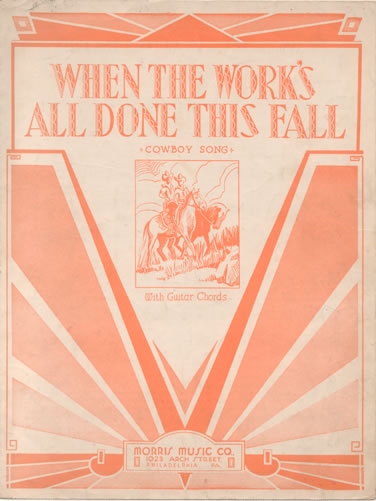
Click Control Above To Hear
1926 "When The Work's All Done This Fall"
Postage Rates
Domestic Letter Rate: 2¢ per oz.
Postal Card Rate: 1¢
Special Delivery Rate: 10¢
Postcard Rate: 2¢
Air Mail Rates: Jan. 1 - mid-Feb.: 8¢/oz. per zone
Mid-Feb.- Dec. 31: 10¢ - 35¢ depending on CAM
Registered Letter Fee: 15¢
Special Handling Fee for Fourth Class Matter: 25¢
Special Delivery Rate for 2-10 lbs. : 15¢
Over 10 lbs. : 20¢
Stamps
The 13¢ Harrison
Flat Plate - Perf 11 - 400 Subject Plates - more than 130 million issued
Designer: C. A. Huston - Engravers: J. Eissler (vignette) - E. M. Hall (frame & lettering)- J. C. Benzing (scrolls)

The 13¢ Harrison stamp was issued to cover the combined postage and registry fee for an ordinary letter. Some felt that this stamp was a makeup stamp issued to appease Postmaster New, whose father was a close political ally of President Harrison, after the 17¢ Wilson stamp had been issued a few months earlier. Whatever the reason, this stamp is now an integral part of the Series of 1922. There is a minor anachronism in the order in which Number lists this (Number 622) and the 17¢ stamp (Number 623). First Day covers were issued at the Philatelic Agency in Washington, D.C. and at Indianapolis, Indiana. Philatelically important covers were also issued from Harrison's birthplace, North Bend, Ohio, serviced by the early First Day collector, Edward Worden. Many important First Day covers were addressed to Worden.
The 1½¢ Rotary Harding
First Day: Aug. 27, 1926
Rotary Imperforate - 400 Subject Plates - more than 2 million issued.

The 1½¢ rotary imperforate Harding, Number 631, is primarily a philatelic stamp, although it was originally issued to fill a need for Mailometer, which was by then a division of Pitney-Bowes. In 1926 Mailometer requested 1½¢ stamps from the Bureau to which they planned on adding Schermack type III perforations for their Chicago customers who still used the older machines. The rotary sheets the Bureau provided had 8½ mm spacing between the panes of 100 stamps, while the flat plate sheets, from which stock every privately perforated stamp was manufactured, other than the experimental Number 459, measured 2½ mm between panes. This additional 6 mm meant that after 10 stamps the perforations would cut nearly 6 mm into the design of the next 10 stamps and so on. Mailometer did not want to go through the expense of retooling their machines to fit this one stamp. They returned the lot to Washington. Although some examples of Number 631 with Schermack type III perforations are known, it is thought that they are fakes. According to Steven Belasco no examples of the 1½¢ imperforate rotary press Harding stamps with genuine Schermack III perforations are known.
When the unused sheets of the imperforate stamps were returned to Washington, it was decided to have the Philatelic Agency sell them to collectors. When these sheets ran out, quite a number more sheets were sold imperforate to fill collector's needs. The earlier sheets returned by Schermack can be told from their later philatelically inspired cousins by the gum breakers on the back of the stamps. The original stamps had no gum breakers while the newer stamps had breakers that kept the stamps from curling. There are far more of the philatelically inspired stamps with the gum breakers and if you can find a copy without the gum breakers it is worth a premium.
First Day Covers are from the Philatelic Agency in Washington, D.C. only.
The 2¢ Rotary Booklet Stamp of 1926
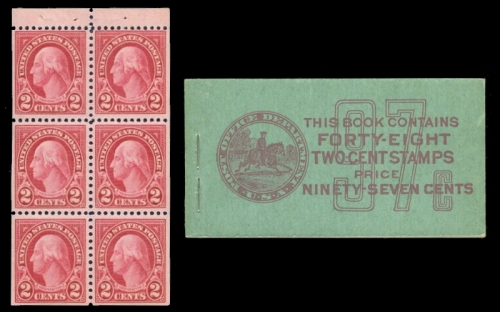
The perf 10 two cent rotary booklet stamp was the first rotary booklet made by the P.O.D. Three booklets were issued: a two pane, a four pane and an eight pane. Only the 2 pane booklet was issued at the Philatelic Agency in Washington, D.C. on the First Day of Issue, August 27, 1926. Although many booklet panes with guidelines must have been made, very few have been found. All of these booklet panes bring substantial premiums, but a full pane with a guideline, of which only one is known (with guideline at right), is truly a special item. There are two singles known with guidelines at bottom.
The 10¢ Map Air Mail stamp of 1926
Flat Plate - Perf 11 - 200 Subject Plates
First Day: February 13, 1926 - more than 42 million issued
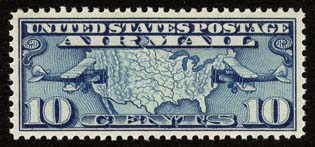
Three stamps were issued to meet new Contract Air Mail (CAM) rates, authorized by the Air Mail Act of 1925 (Kelly Act) and referred to in short as "CAM's". These rates varied depending on the number of zones the mail had to cross. To meet all possible combinations of Zone rates for sending a one-half ounce letter, the following rates were needed: 5¢, 10¢, 15¢, 20¢, 25¢, 30¢, and 35¢. Other than the 5¢ rate, all of the other rates could be made by combinations of the three values in this set. This point turned out to be moot, however, when a uniform rate of ten cents per half ounce regardless of distance was introduced in 1928. The Contract Air MAil Service lasted until 1934.
The 10¢ stamp introducing this new service was met with big fanfare and was promoted heavily along the Ford Motor Company contract route which moved the mail via air between cities in the Midwest. As usual the stamp was issued First Day at the Philatelic Agency in Washington, D.C., but also in the following cities along the "Ford" route: Detroit and Dearborn, Michigan; Chicago, Illinois; and Cleveland, Ohio.
The 15¢ Map Air Mail stamp of 1926
First Day: September 18, 1926
More than 15 million issued
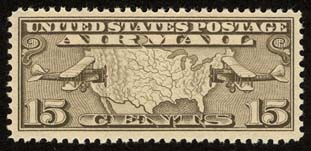
First Day Covers of the 15¢ stamp were only issued at the Philatelic Agency in Washington, D.C. Both the 10¢ and 15¢ stamps were well received by collectors and are easily found in mint condition. However, covers with correct usage from this period are quite scarce and bring large premiums over the mint stamp.
Although the "Map" Air Mail stamps form a set (Number C7-C9), the 20¢ stamp was not issued until 1927.
The 2¢ Sesquicentennial Exposition
May 10, 1926
Flat Plate
Perforated 11 - 200 Subject Plates -307,731,900 issued

The Sesquicentennial Exposition stamp, commemorating the 150th anniversary of American Independence, was issued to promote the Sesquicentennial Exposition to be held in Philadelphia from June 1 through November 30, 1926. The promoters of this event had asked the Post Office to issue a set of four stamps, a one, two, five, and ten cent stamp, similar to the Pan Pacific Commemoratives of twelve or so years earlier. With the cost overruns of the Norse American Issue fresh in his mind, Postmaster New agreed to this commemoration, or promotion, but with one denomination only, the 2¢.
Ironically, the engraving of the Liberty Bell on this stamp is not from the original bell, but from the replica bell that hung over the main entrance to the Philadelphia Exposition. The stamp was issued First Day at the Philatelic Agency in Washington, D.C., and at Philadelphia and Boston. Collecting First Day Covers was already becoming a fad and the Sesquicentennial Exposition stamp is not hard to find on First Day cover or in mint condition. It was not much used for postage however, and covers from this period showing correct usage bring a premium.
The 5¢ Ericsson Memorial
May 29, 1926
Flat Plate - Perforated 11
200 Subject Plates - 20,280,000 issued

This stamp is another filled with ironies. It was the first U.S. commemorative stamp issued in the vertical format, that is taller than wide. Whether it had anything to do with the fact that we had just honored Norway a year earlier with the Norse American commemoratives is not certain, but it did honor a Swedish American, John Ericsson, whose great claim to fame was the "Monitor", a ship that helped turn the tide in the Civil War. The stamp again promoted a current event, the unveiling of the Ericsson Memorial in May of 1926, and was issued to coincide with the event. Amazingly, the stamp does not memorialize John Ericsson, it merely honors the unveiling of the statue honoring him, nor does the memorial itself place Ericsson in a place of prominence. Ericsson is the little statue under the large allegorical figure representing "Vision" directly behind.
The stamp was First Day issued at the Philatelic Agency in Washington, D.C. and in New York City, Chicago and Minneapolis.
The 2¢ Battle of White Plains
October, 1926
Flat Plate - Perforated 11
400 Subject Plates - 40,639,485 issued

This stamp was another of the sesquicentennial stamps of that era, marking the 150th anniversary of the "Battle" of White Plains. It too was issued to promote a celebration commemorating the anniversary, not the battle itself. There was some disagreement as to whether the Post Office Department could afford to issue this commemorative, an idea which must seem strange today, when many issues are printed solely to generate revenue. Eventually, a compromise was reached in which the size of the stamp was reduced to lower production costs, an idea that was copied on many of the subsequent commemoratives, collectively known today as the "two cent reds".
The International Philatelic Exhibition was held in New York City that year and it was decided to issue First Day stamps from there as well as White Plains, N.Y. Strangely, the stamp was not issued First Day by the Philatelic Agency in Washington, D.C., perhaps because Postmaster New and other higher-ups in the P.O.D. were in New York to promote the International Philatelic Exhibition.
Although "First Day" covers with October 16, 1926 date stamps are known, this is widely regarded as an error - it is believed the postal clerk simply forgot to change the date stamp - the stamps were officially issued October 18. First Day covers of this stamp were the first to be largely issued with artwork, what is known today as "cachets".
The White Plains Souvenir Sheet Another milestone made by this commemorative was the issuance of souvenir sheets by the International Philatelic Exhibition. The 25 stamp souvenir sheet with marginal inscriptions was the first of its kind. Only a little over 100,000 were printed and many of those were subsequently broken down to sell as singles and blocks when the sheets proved unpopular with collectors of the day. Today, the sheet brings quite a premium over the fifty cents it originally sold for at the International Philatelic Exhibition in October of 1926.
The following postage stamp varieties were first issued by the U.S. in 1926
No new varieties of U.S. Special Handling stamps were issued in 1926
No new varieties of U.S. Special Delivery stamps were issued in 1926
No new varieties of U.S. Postage Due stamps were issued in 1926
Ordinary issue
Number 583a - 2¢ Washington rotary perf 10 booklet (pane) - First Day: 8/27/1926
Number 588 - 7¢ McKinley rotary perf 10 - First Day: 5/29/1926
Number 589 - 8¢ Grant rotary perf 10 - First Day: 5/29/1926
Number 590 - 9¢ Jefferson rotary perf 10 - First Day: 5/29/1926
Number 622 - 13¢ Benjamin Harrison Flat Plate Perf 11 - First Day: 1/11/1926
Number 631 - 1½¢ Harding rotary imperforate - First Day: 8/27/1926
Number 634 - 2¢ Washington rotary perf 11 x 10½ - First Day: 12/10/1926
Commemoratives
Number 627 - 2¢ Sesquicentennial Exposition
Designers: C. A. Huston - Engravers: John Eissler (vignette, ornaments) - E. M. Hall (lettering, frame)
Number 628 - 2¢ Ericsson Memorial
Designers: C. A. Huston - Engravers: L. S. Schofield (vignette, frame) - F. Lamasure (lettering, numerals)
Number 629 - 2¢ Battle of White Plains
Designers: C. A. Huston - Engravers: John Eissler (vignette, ornaments) -
H. I. Earle (lettering, numerals)
Number 630 - 2¢ Battle of White Plains Souvenir Sheet of 25
Air Mail
Number C7 - 10¢ "Map" Air Mail
Designers: C. A. Huston - Engravers: J. C. Benzing (vignette, frame) - E. M. Hall (lettering, numerals)
Number C8 - 15¢ "Map" Air Mail
Designers: C. Huston - Engravers: J. Benzing (vignette, frame) - E. Hall (lettering) - F. Lamasure (numerals)





